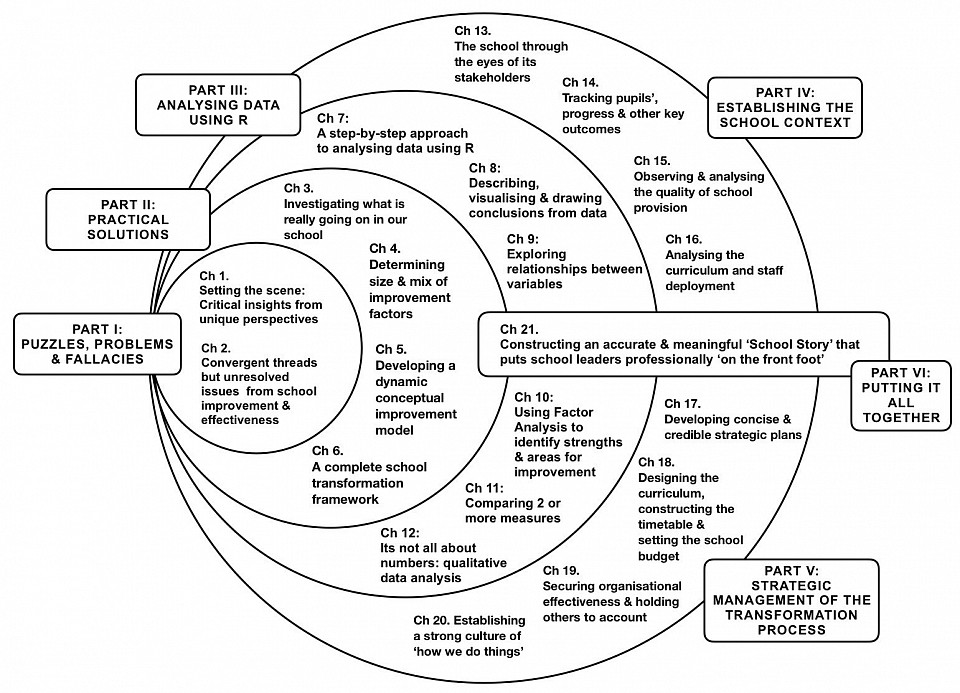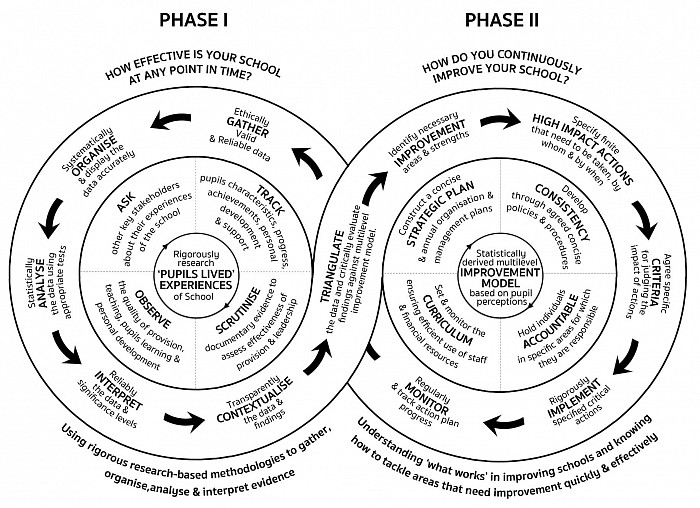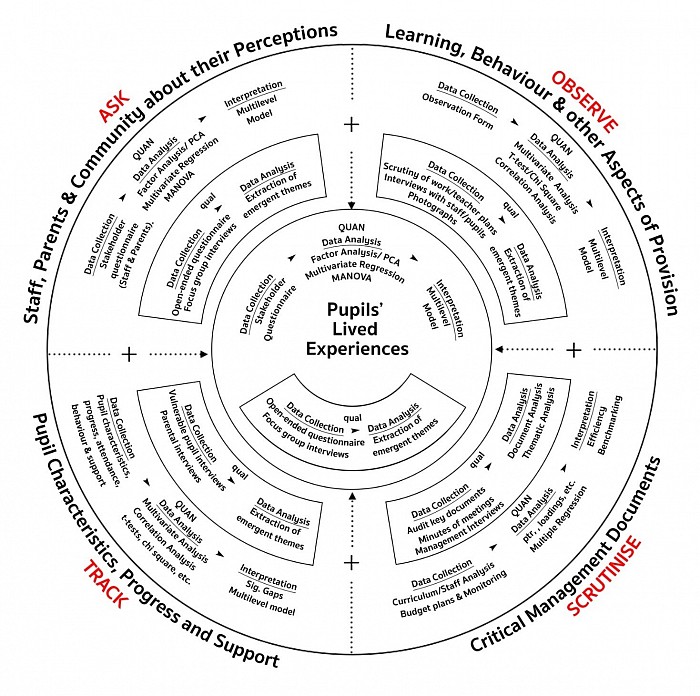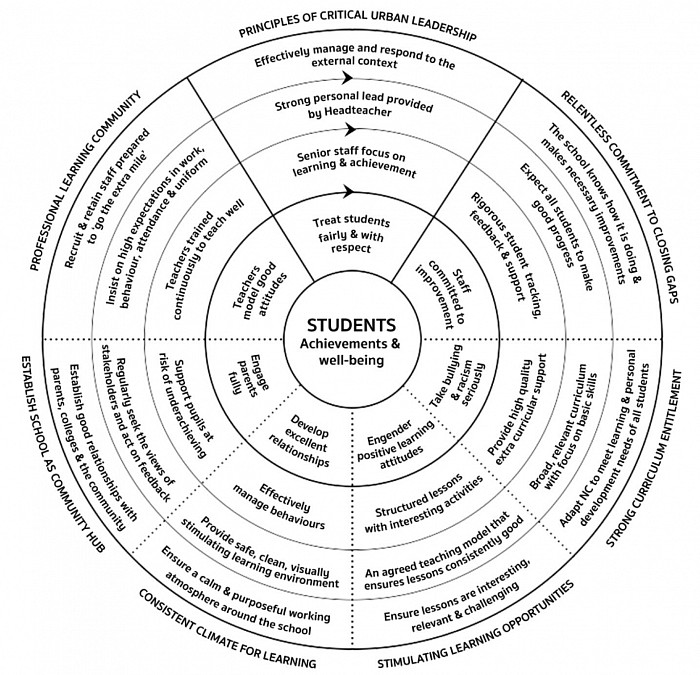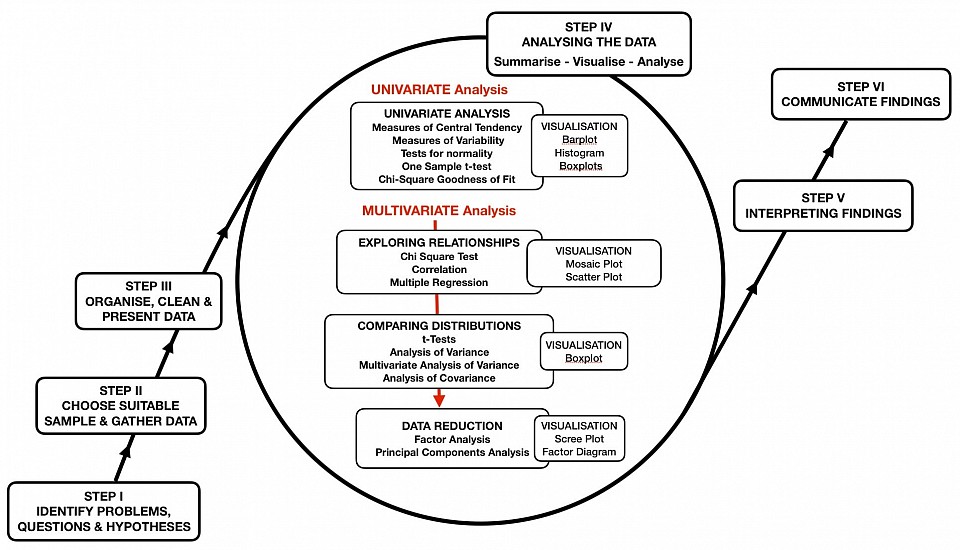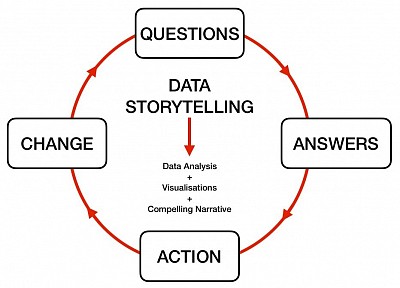COMING SOON…..
A ‘One Stop Shop’ Handbook for School Leaders
Our ‘go to’ Handbook for School Leaders entitled ‘LEADING DYNAMIC SCHOOL TRANSFORMATION: The Importance of Understanding Data, Context and Children’s Perceptions’, challenges existing approaches to school improvement and school effectiveness. It provides a comprehensive practical guide to support school leaders with most aspects of the school improvement process. The Handbook has 21 chapters organised into 5 parts as shown in the figure that follows.
Part I focuses on WHY WE NEED TO DO THINGS DIFFERENTLY. It interrogates the findings from school effectiveness and school improvement research and considers in detail the convergent themes and common limitations, together with the issues that emanate from the current school accountability framework.
Part II proposes PRACTICAL SOLUTIONS in response to the common limitations identified in Part I. It describes models and frameworks that contribute to securing sustainable school transformation. There are three essential components. A comprehensive research design to investigate the school context; a multilevel conceptual school improvement model and most importantly, the SCHOOL TRANSFORMATION FRAMEWORK that forms the core of the book, and sets out what good school leaders actually do.
Part III provides in-depth guidance on rigorously ANALYSING SCHOOL DATA using the industry-standard statistical software called R. The chapters in this section go well beyond the sometimes misleading use of percentages and mean averages by outlining how to use multivariate statistical tests and techniques to answer more challenging questions posed by school leaders.
Part V addresses the question: HOW EFFECTIVE IS OUR SCHOOL? It describes four research-based strategies, accompanied by tried-and-tested tools, that are essential in supporting schools to construct a forensic understanding of their CONTEXT; most importantly its strengths and weaknesses.
Part IV seeks to answer the question WHAT MUST WE DO TO IMPROVE OUR SCHOOL? and describes four extensive strategies, each accompanied by electronic tools, that support school leaders to plan, implement and sustain school transformation using the conceptual multi-level SCHOOL IMPROVEMENT MODEL proposed in Part II.
Part V explains how to construct a meaningful SCHOOL STORY that is embedded in the day-to-day work of school leaders, and documents a schools’ transformational journey. The approach described, together with a detailed template, draws heavily on the content of other chapters in the book together with recent developments in data storytelling. The book concludes by discussing the CULTURAL SHIFTS that need to be taken from within the profession, to bring about school transformation in a sustainable and ethical way.
THE SCHOOL TRANSFORMATION FRAMEWORK
Our handbook for school leaders is underpinned by a unique School Transformation Framework that was developed by the author over a twenty-year period as a school leader, researcher and consultant. The Framework responds directly to two critical questions that school leaders must ask on a continuous basis. These are synonymous with the two identified phases in the infinity diagram, namely: How effective is our school? (Phase I) and How can we improve our school? (Phase II). The outer ring of the framework sets out the actions that are necessary to embed the leadership strategies identified in the framework. Taken together, the activities within the framework encompass was leaders actually do in transformational schools.
The central hub in Phase I of the school transformation cycle consists of a research-based design to investigate the context of the school. At the core of Phase II sits a conceptual multilevel improvement model that sets out statistically derived factors that are necessary for improvement to take place. Both of these are described in the book. The framework is dynamic as the processes and straggles within it are continuous.
RESEARCHING THE SCHOOL CONTEXT
At the core of Phase I of the School Transformation Framework lies a coherent research design that supports a forensic analysis of the school context at any point in time.
Each of the techniques included in this research design are discussed in detail in successive chapters in Part IV of the book. These involve gathering and analysing: stakeholder perceptions; student performance data; observation data; and data about the curriculum and staff deployment.
A CONCEPTUAL SCHOOL IMPROVEMENT MODEL
Part V of the book in underpinned by a conceptual multilevel school improvement model that is comprised of 28 school improvement factors, that are arranged in four levels. The existence, size and interrelationship between these factors was statistically derived as part of the authors doctoral and post-doctoral research. A synergistic focus on these factors at an individual, classroom, school and contextual level has been shown to bring about improvement in a variety of contexts.
Four chapters in Part V of the book combine to support the implementation of the conceptual improvement model on the ground. These chapters provide guidance on: strategic planning and setting and monitoring the school budget; setting the curriculum and constructing the school timetable; securing organisational effectiveness and holding staff to account; and establishing a culture of ‘how we do things around here’.
ANALYSING SCHOOL DATA
The handbook provides detailed introductory guidance on analysing both quantitative and qualitative school data using a wide range of statistical techniques. The step-step-step guidance always begins with a question or hypothesis proposed by school leaders, which in turn determines the most appropriate data analysis techniques.
The industry-standard statistical open-source software R is used to generate tables and charts, and to conduct statistical tests. Exemplar R-code and worked examples leader the reader through each type of analysis. An introduction to thematic analysis of qualitative data is also provided to assist with interpretation of statistical outcomes.
THE SCHOOL STORY
The school story brings together the strategies, techniques and tools within the school transformation framework are embedded in the day-to-day work of schools leaders, and in turn are used to inform a ‘School Story’ which documents the improvement journey of a school in a concise and structured way. A detailed but flexible template and guidance for its implementation are provided.
